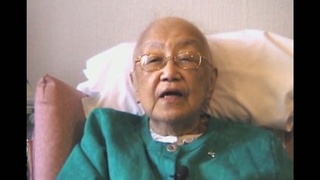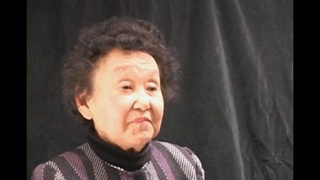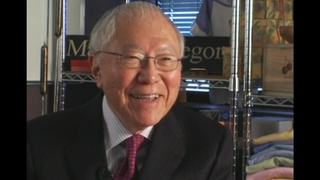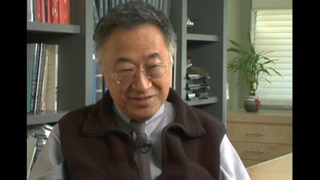Interviews
The impact of Pearl Harbor on his family
I*: How was your family affected?
Oh, the night of Pearl Harbor on December 7, 1941, we were having supper and there was a knock on the door and I went to answer it. And much to my surprise, there were three tall RCMP officers at the door, and they asked if a Shuichi Sasaki lived here and I said, Yes. They came in and they went through all, every, every room in our house, and every dresser, and after they went I remember, I remember that all my father's personal papers were gone; insurance policies, birth certificates, passports, they took it all away, and that very night they took my father away. For about two weeks we didn't know where he was, and finally they told us he was in the immigration detention place down by the waterfront of Vancouver. And they were there, my father was kept there. There were about forty Japanese rounded up that night I heard, and they were there for about a month and then they were, my father and the forty people that were interned were sent to Seebe prisoner of war camp in Alberta, in Northern Alberta, and my father wrote me that it was full of German, prisoners of war they had brought from Germany that they had captured, all the way from Germany they were kept there. Then from Seebe, Alberta, there, he was transferred to Petawawa in Ontario, and then to, he, the final internment camp was at Angler. [Interruption]
I: Why do you think your father was targeted?
Oh, my father was targeted, I assumed that because he was doing trade with, promoting trade between Japan and Canada, he was exporting logs and lumber through Mitsui Company, Limited, that they had an office in Seattle, and my father took frequent trips there to arrange shipments to Japan. And I remember accompanying him to Seattle as a boy on some trips, I think, when he went to the office. What I remember most was these Japanese businessmen from Mitsui, when they came to Vancouver, my father entertained them, and they were avid golfers, and I caddied for, for them when they, my father took them out golfing. [Interruption]
I: What was your mother's experience?
Oh, my mother, my mother had a hard time because when I look back, January following Pearl Harbor, there was a order-in-council by, issued by Ottawa, that all Japanese nationals had to be out of the hundred-mile radius of the coast by the middle of January. And since I was born in Japan and I was classed as an enemy -- a Japanese national and an enemy alien, so I had to leave university and out of that radius. Fortunately, my sister had married about a year earlier, and their in-laws lived in Calgary, so they said, Fred could come and live with us, when we had to move out. So I left Vancouver and the curfew was on, I remember. There were two other students in the same boat: Saburo Takahashi and Nori Nishio, they were all classed as Japanese nationals. They went to Edmonton, Alberta, and I went to Calgary. So my, my mother was left with my six younger sisters all by herself, because my father had been interned and I had to leave for Calgary. And it was a very, very hard time for her. [Interruption]
I: And where did the women end up?
Fortunately, one day, I think it was around March, 1942, Tommy Shoyama of the New Canadian, editor of the New Canadian, phoned and said that if my mother and my sisters left in the next two or three days, that they could go to Kaslo because of the group from the United Church in Vancouver that was leaving for Kaslo, there was an opening for my mother, so the New Canadian staff came and my mother told me that they came and helped, helped the family pack in a hurry, and they left for Kaslo, B.C.
* "I" indicates an interviewer (Teri Yamada).
Date: September 24, 2004
Location: Toronto, Canada
Interviewer: Teri Yamada
Contributed by: Sedai, the Japanese Canadian Legacy Project, Japanese Canadian Cultural Center
Explore More Videos

Experiences during World War II
(1918-2004) Interned in Slocan during World War II. Active member of the Japanese Canadian community.

Family life in a Japanese Canadian internment camp in Slocan
(b. 1920) Incarcerated during World War II. Active member of the Japanese Canadian community

Chose to go back to Japan
(b.1924) Japanese Canadian Nisei. Interpreter for British Army in Japan after WWII. Active in Japanese Canadian community

Redress Movement in Canada
(b.1924) Japanese Canadian Nisei. Interpreter for British Army in Japan after WWII. Active in Japanese Canadian community

Social activities in Tashme
(b.1920) Japanese Canadian Nisei. Established the Ikenobo Ikebana Society of Toronto

Choice to move east or go to Japan
(b.1920) Japanese Canadian Nisei. Established the Ikenobo Ikebana Society of Toronto

Undergraduate studies interrupted following Pearl Harbor
(b. 1921) Nisei businessman. Established "Made in Oregon" retail stores

Difficulty getting work during World War II
(b. 1921) Nisei businessman. Established "Made in Oregon" retail stores

Difference between experiences of youth and older people in WWII camps
(b.1929) Pioneer medical researcher in tissue transfer and organ transplantation.

Escaping to a small village in the mountains during the World War II (Spanish)
(b. 1937) Professional journalist

Japanese community in Mission
(b. 1922) Canadian Nisei who was unable to return to Canada from Japan until 1952

Reason to come back to Canada in 1954
(b. 1922) Canadian Nisei who was unable to return to Canada from Japan until 1952

The identity of Nikkei Canadians seen in the Buddhist Church (Japanese)
Tsuda College President, researcher of Nikkei history

Learning from Nikkei (Japanese)
Tsuda College President, researcher of Nikkei history

Father in camp but learning from history books
Giant Robot co-founder and publisher
